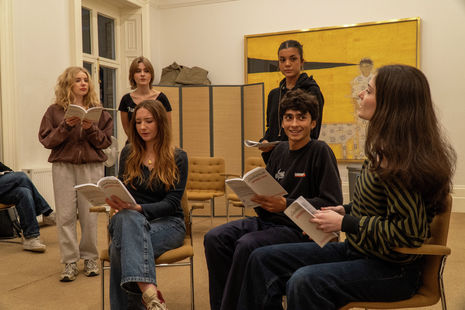Weaving the web: making a freshers’ play
Director Dhyan Ruparel discusses the creation of CUADC’s anticipated murder mystery, Spider’s Web

It’s the first readthrough. None of the actors have read the script – I wanted to keep it a surprise. Lo and behold, when the final scene comes and the murderer is revealed, they gasp, and I smile. There’s a reason Agatha Christie is known for her plot twists.
When I interviewed to direct Spider’s Web – one of three freshers’ plays produced by CUADC in week six of Michaelmas – I didn’t know the play. I just wanted to direct in Cambridge, and where better than the ADC? I read furiously, taking notes like Hercule Poirot himself. When I was done, I could see the entire thing on the ADC stage: the slapstick comedy, the moments of silence, the moon-lit drawing room where the text is set. It’s a classic text, full of bold characters that leap out of the page, but is less performed than Christie’s other plays. I suddenly felt I had a mission: to make this gem of a murder mystery feel as fresh, comic and tense as possible. In other words, I wanted it to feel like an episode of The Traitors brought into the theatrical space.
“I just wanted to direct in Cambridge, and where better than the ADC?”
I quickly realised that the process of mounting a freshers’ play is unlike any other Cambridge show. The three plays are chosen by the CUADC committee, rather than pitched by directors. I only oversaw the recalls for actors; initial auditions took place before I was involved. The production team was also chosen by interview, meeting each other only three weeks before our first show. Naturally, this came with its challenges. As our lighting designer, Yusaf, told me: “The best thing about working on a freshers’ play is that it takes all of the best aspects of amateur theatre and turns it up to the max. No-one knows what they’re doing. Everyone is winging it.” Indeed, that sense of ‘winging it’ has become the spirit and motivation behind the project. From training on flame-testing fabrics to learning how to be a DSM, it’s simultaneously a technical bootcamp and show of its own.
In spite of these challenges – or, perhaps, as a result of them – there’s something magical about the process. The ensemble cast have embodied this well. As Lucy, who plays Hugo Birch, said: “It’s been really, really rewarding, being surrounded by such a lovely working environment, you know! It’s a murder mystery but we’re still somehow able to have a lot of fun.” Rehearsals have indeed been filled with laughter and experimentation, with many of the actors embracing difficult and strong characters. Some, like Mary, play the opposite sex, which she describes as transformative: “It’s really helped me grow as an actor. It has given me new perspectives on how I act and how I interact with given roles and how I will carry that into the future.” Indeed, from the readthrough to our last rehearsal, her transformation into this male character has been brilliantly entertaining to watch, culminating in a precise and comic performance. I’ve challenged each actor to work like this, moving beyond stereotypes and looking deeply into their position within the mystery, a task which has enhanced all of our appreciation for Christie’s writing. It makes for equally excellent moments of drama and comedy; even having heard all of the jokes, I will admit to laughing every single time.
“Surely, in the wake of Spider’s Web, many long CamDram journeys will continue”
Similarly, the limited time-scale has not dampened any ambition in design and vision. The team enjoys the challenge, bringing their own interests and experiences: from set designer Sadie’s background in fine art, or cast member Leo’s training in ballet. The production will use both; visual references draw equally from Christie’s period and more contemporary styles. Costume designer Elsbeth has created timeless designs, which emphasise character over period accuracy, exaggerating and strengthening their performances through their vivid colours and individual touches for each role. Meanwhile, sound designer Stacy is underscoring movement sequences between scenes, displaying the latent tensions in Christie’s play in a way that lends the production a propulsive drive, intensifying the sense of urgency and time restriction. The result is a truly unique product, both removed from the show’s first West End production in 1954, yet fully reflective of its characters and their flavours. A real balancing act, in many ways against all odds.
Now, as we look ahead to the show week, I reflect on the experience of directing a freshers’ play with the same thrill as the first readthrough. As with lots of amateur theatre, there are many lacks: time, availability, space to rehearse, money. Yet, working on Spider’s Web, I’ve mainly seen abundance. Whether that’s an abundance of energy and compassion in the short time-scales, or an abundance of talent and precision in the craft, it is a testament to this company that it has been such a smooth project, and always a pleasure to lead. Moreover, there is plenty of brilliance in the final show, a fast-moving night out that audiences will have to be in the room to appreciate. Though the show may be reminiscent of The Traitors, none of these freshers will be banished at this Roundtable – surely, in the wake of Spider’s Web, many long CamDram journeys will continue.
Spider’s Web runs at the ADC Theatre from Tuesday 18th November to Saturday 22nd at 7.45 pm.
 News / Gov declares £31m bus investment for Cambridge8 December 2025
News / Gov declares £31m bus investment for Cambridge8 December 2025 News / Uni redundancy consultation ‘falls short of legal duties’, unions say6 December 2025
News / Uni redundancy consultation ‘falls short of legal duties’, unions say6 December 2025 News / Pembroke to convert listed office building into accom9 December 2025
News / Pembroke to convert listed office building into accom9 December 2025 Science / Fancy doing research this summer? A guide to getting involved as a student8 December 2025
Science / Fancy doing research this summer? A guide to getting involved as a student8 December 2025 News / Write for Varsity this Lent3 December 2025
News / Write for Varsity this Lent3 December 2025










